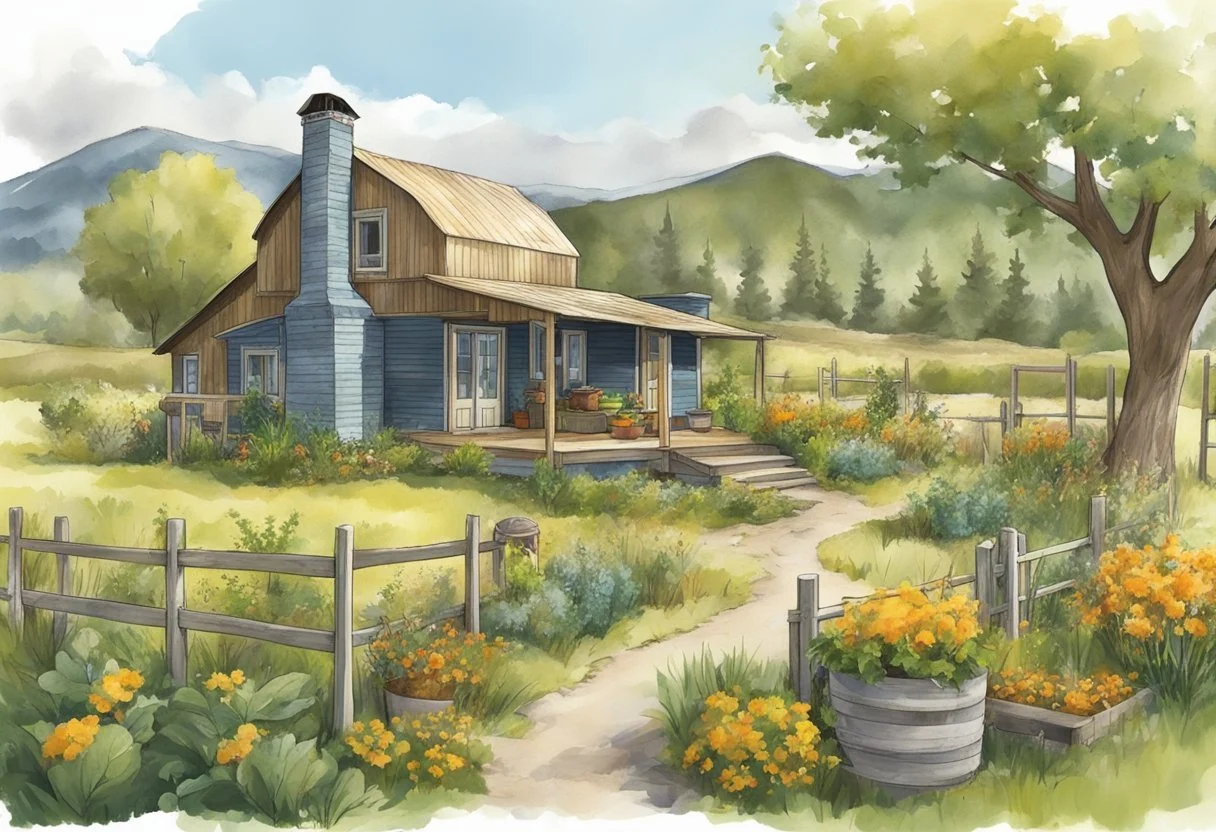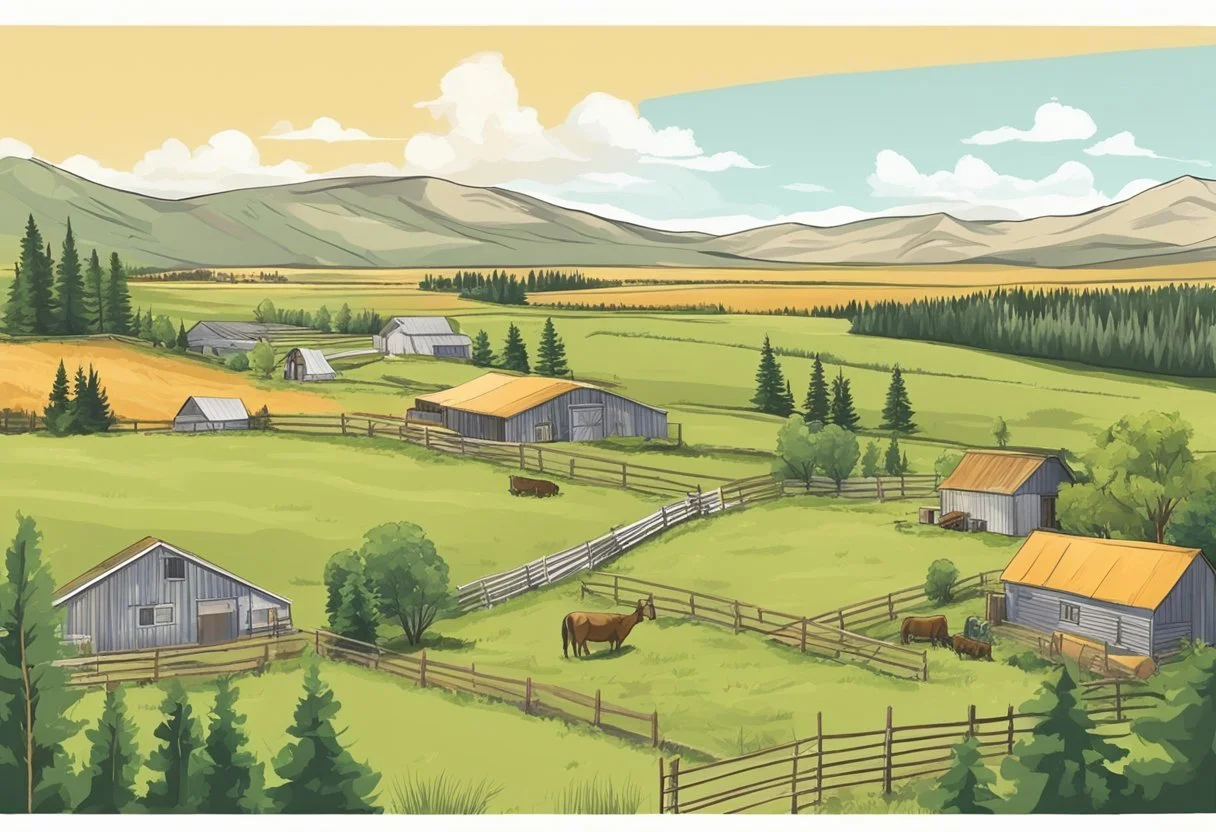Homesteading in Idaho
A Comprehensive Guide for Beginners
This Article is Part of Our Guide Homesteading State by State
Homesteading in Idaho on a small acreage has become increasingly popular in recent years, as people seek a simpler, more self-sufficient lifestyle away from urban centers. The idea of living on a small plot of land, growing one's own food, and raising animals while maintaining a close connection with nature can be incredibly appealing. Idaho provides an ideal setting for this way of life, with its diverse natural resources, fertile soil, and favorable climate.
For those considering embarking on this journey, it's important to recognize that homesteading in Idaho requires commitment, planning, and dedication to learning a wide range of practical skills. Before making the leap, potential homesteaders must assess their goals, resources, and personal traits that are necessary for success. Identifying the right location, understanding the local regulations, and preparing for the unique challenges that come with a rural lifestyle are key components in laying the foundation for a thriving homestead.
The following article delves into the necessary steps and considerations for those interested in pursuing the dream of homesteading in Idaho on a small acreage. From land selection and resource management to building connections within the local community, this guide aims to provide valuable insights for aspiring homesteaders looking to embark on a sustainable, fulfilling, and rewarding journey in the Gem State.
What is the Homesteading Exemption in Idaho and is it Related to Farming?
In Idaho, the homeowner's exemption is a property tax relief program for homeowners, but it is not directly related to farming.
The key details:
The homeowner's exemption lowers the taxable value of an owner-occupied primary residence.
To qualify, the owner must occupy the property as their primary dwelling and meet occupancy requirements.
It provides tax relief specifically for qualifying residential homestead properties.
Agricultural land may qualify for reduced tax assessments under Idaho's agricultural land valuation law if used commercially for farming.
The ag land law has separate eligibility rules focused on commercial agricultural operations.
It is distinct from the general homeowner's exemption for residential homeowners.
In summary, Idaho's homeowner's exemption applies to primary residences only. Agricultural land may receive different tax treatment intended for commercial farming under the agricultural land valuation law. The homeowner's exemption is not related to supporting agricultural operations.
Understanding Homesteading in Idaho
Homesteading in Idaho has gained popularity in recent years, as more people seek a self-sufficient and sustainable lifestyle. Idaho, known for its vast expanses of wilderness and fertile soil, provides an ideal environment for homesteaders to thrive. This article will provide essential information on what it takes to start and maintain a successful small-acreage homestead in Idaho.
Idaho offers a variety of climate zones, ranging from the more temperate Pacific Northwest climate in the northern part of the state to the drier, arid conditions in the south. This diversity allows for a wide range of crops and livestock to be raised successfully, depending on the specific location of the homestead. Additionally, the state is home to numerous rivers and lakes, which provide essential water resources for both irrigation and livestock.
A significant factor when considering homesteading in Idaho is the state's relatively low cost of living, making it more accessible for individuals and families to establish and maintain their homesteads. However, there are some regulations and zoning laws that potential homesteaders need to be aware of, depending on the location and size of their intended property.
An essential aspect of successful homesteading is selecting the right land for the chosen enterprises, whether it be crop production, livestock, or even aquaculture.
Some factors to consider when choosing land for a homestead in Idaho include:
Soil quality and fertility
Access to water
Climate and weather patterns
Proximity to markets and resources
Once the right land is chosen, implementing efficient and sustainable systems is crucial for a successful homestead. These systems can include but are not limited to:
Integrated pest management
Permaculture design principles
Renewable energy sources, such as solar or wind power
In conclusion, homesteading in Idaho offers a unique opportunity for individuals and families to live a self-sufficient and sustainable lifestyle. Understanding the state's varied climate zones, regulations, and available resources is crucial for achieving success on a small-acreage homestead. By planning carefully and implementing efficient systems, homesteaders in Idaho can build a thriving and rewarding life in harmony with their environment.
Defining Small Acreage Homesteading
Small acreage homesteading refers to the practice of establishing a self-sufficient lifestyle on a limited amount of land. Typically, small homesteads involve a range of practices that allow the owner to live off the land, including growing their own food, raising livestock, and utilizing renewable energy sources for energy needs. This type of off-grid living enables individuals and families to reduce their dependence on modern supply chains, fostering a more sustainable and eco-friendly way of life.
One of the key components of small acreage homesteading is the efficient use of available space. Given the limited land area, every square foot must be well-thought-out to maximize productivity. This often includes implementing various gardening techniques such as raised beds, vertical gardens, and companion planting. Additionally, utilizing dual-purpose livestock, which can provide multiple sources of food and other resources, proves to be advantageous in small homesteading settings.
Another essential aspect of homesteading on a small acreage is the reliance on off-grid energy solutions. Solar panels, wind turbines, and hydroelectric power can all be harnessed to generate electricity for homes, thereby reducing the dependency on the grid. These renewable energy sources are not only environmentally friendly, but they also promote self-sufficiency and reduce living expenses in the long run.
Lastly, the core principle of small acreage homesteading lies in adopting a self-sufficient lifestyle. While not all homesteaders will be able to achieve complete self-sufficiency, it is essential to aim for reducing external dependencies as much as possible. This involves learning valuable skills - such as carpentry, gardening, animal husbandry, and food preservation - to deal with daily life and potential situations that may arise.
In summary, small acreage homesteading involves a combination of efficient land use, off-grid energy solutions, and a self-sufficient mindset. By implementing multisource sustainability practices, small homesteads aim to reduce dependency on modern supply chains while promoting a greener, more eco-friendly lifestyle.
Real Estate Overview
When considering homesteading in Idaho, it's essential to have a confident and knowledgeable understanding of the real estate market. The region offers various properties for sale, suitable for small acreage homesteading.
In Idaho, the average listing age of homestead properties for sale varies depending on the region. Generally, you can expect most listings to be on the market for a few months, which gives potential buyers ample time to study different options and make informed decisions.
The purchase price and listing price for Idaho homestead properties depend on multiple factors, including property size and location. On average, the price per acre ranges from $2,000 to $6,000. However, this can vary greatly depending on factors such as accessibility, available utilities, and soil quality. It's crucial to assess your budget and homestead requirements properly in order to find a suitable property.
Property sizes in Idaho vary, with acreages ranging from a few acres to several hundred acres. For small acreage homesteading, you might consider properties between 1 and 10 acres. These smaller properties can be found across the state, with a higher concentration in regions with fertile soil and abundant water availability.
To summarize, understanding the real estate landscape in Idaho is an important aspect of small acreage homesteading. By familiarizing yourself with property listings, average listing ages, purchase prices, acreage sizes, and regional differences, you can confidently find a suitable property for your homesteading dream.
Geographical Insights
Idaho offers a diverse landscape for homesteading, with different regions providing unique opportunities for small acreage farming. In Central Idaho, the rugged terrain and dense forests are rich in timber, making it ideal for those looking to build log homes or cultivate woodland resources. The region boasts rivers and lakes that provide fresh water and fish - a vital component for any sustainable homestead.
Southern Idaho, on the other hand, is characterized by its arid climate and semi-desert landscapes, perfect for raising livestock or farming drought-tolerant crops. The Magic Valley and Treasure Valley regions of Southern Idaho are particularly suited for agriculture, given their fertile soil and access to irrigation.
The Panhandle of Idaho consists of a more temperate climate and rolling hills, providing ample opportunities for both crops and pasture land. Counties like Bonner and Elmore are popular destinations for those looking to homestead in this region, offering a mix of wooded and open land, as well as access to rivers that can be utilized for irrigation or recreation.
In Blaine County, the landscape transitions from semi-arid plains to mountainous terrain, creating a variety of microclimates that can support diverse farming techniques. With its picturesque views and strong community ties, Blaine County is a popular choice for those in search of a more self-sufficient lifestyle.
Southwestern Idaho encompasses the bustling Treasure Valley region, known for its thriving agricultural industry, as well as portions of the more rugged Owyhee Mountains. The varied terrain in this area means that there is something for everyone, whether it be flat, fertile land for farming or more secluded, forested land for those seeking solitude.
In each of these areas, potential homesteaders should consider factors such as access to resources, proximity to markets, and the type of crops or livestock that may be best suited to the region's climate and terrain.
By understanding the unique characteristics of each region of Idaho, homesteaders can make informed decisions about the best location for their particular needs, maximizing their chances of success in their chosen endeavor.
Climate and Soil Quality
Idaho's climate varies across the state, with a semi-arid continental climate prevailing in the south and a more temperate climate in the north. The average annual temperature ranges from 40°F to 55°F, while precipitation ranges from 10 inches to 50 inches annually. This variation in climate allows for a diverse range of crops to be grown throughout the state.
The growing season in Idaho typically spans from April to September, offering plenty of time for a variety of crops to reach maturity. The USDA Plant Hardiness Zones for Idaho range from 4a to 7b, with the coldest temperatures occurring in the mountainous regions. It is essential to select crops suitable for the specific hardiness zone to maximize production on a small acreage.
Soil quality in Idaho varies as well, with rich volcanic and alluvial soils in some regions and rocky, shallow soils in others. Some of the most fertile soils can be found in the Snake River Plain, which is renowned for producing high-quality potatoes. Other crops, like grains, legumes, and fruits, also grow well in the fertile regions.
In order to ensure success in homesteading, it is crucial to invest time in understanding and improving the soil quality on your small acreage. Conducting a soil test is highly recommended to determine the soil's pH, nutrient levels, and organic matter content. This information will enable you to select appropriate crops and apply the necessary amendments to improve your soil.
By considering Idaho's diverse climate and soil conditions, homesteaders can optimize their small acreages for growing a wide range of crops. Adapting to the specific hardiness zone and taking care to manage soil quality will significantly impact the overall success of a small acreage homestead in Idaho.
Tax and Legal Aspects
When considering homesteading in Idaho on a small acreage, it's essential to understand the tax and legal aspects associated with this lifestyle. Before getting started, understanding the different types of taxes and permits for homesteading is crucial.
Property tax is one of the most vital types of taxes to be aware of as a homesteader. In Idaho, property tax is based on the taxable value of the property, which includes the land and any improvements made to it. However, there could be tax exemptions for a portion of your property's assessed value, depending on its use and the county.
Another type of tax to be familiar with is sales tax. Idaho imposes a sales tax on most goods and services, including items used for homesteading, such as building materials and tools. It's essential to budget for this expense to avoid any surprises.
The legal aspects of homesteading in Idaho can involve a variety of permits and restrictions. Some permits may be necessary for activities like building structures, keeping animals, or installing a septic system. It's essential to check with local authorities for any specific requirements in your area.
Additionally, homesteaders should be knowledgeable about the laws surrounding tax exemptions for their homestead. In Idaho, under certain conditions, a portion of a homestead's assessed value may be exempt from property taxes. However, this exemption doesn't absolve homesteaders of other taxes like sales tax or income tax.
Creditors can also play a role in the tax and legal aspects of homesteading. In Idaho, homestead exemption laws protect property owners from losing their homes due to outstanding debts. This protection can vary depending on various factors like the size of the property and the owner's circumstances.
In conclusion, understanding the tax and legal aspects of homesteading in Idaho on a small acreage is critical for a successful experience. By being aware of property tax, sales tax, permits, exemptions, restrictions, and laws regarding creditors, homesteaders can navigate the process with confidence and clarity.
Energy Sources for Off-grid Homesteading
When homesteading in Idaho on a small acreage, it is essential to consider off-grid energy sources to support daily living. There are several options available, including solar, wind power, and other alternative methods.
Solar power is a reliable and sustainable option for off-grid living. With abundant sunlight in Idaho, solar panels can capture and convert energy to power a homestead. Solar power systems include photovoltaic (PV) panels, a charge controller, batteries for energy storage, and an inverter to convert the power to alternating current. The capacity of the solar system depends on the energy needs of the homestead and available space for panel installation. It's essential to consider initial costs, maintenance, the lifespan of the components, and any relevant tax incentives when choosing solar energy.
Wind power is another viable option for generating electricity for off-grid homesteading. Wind energy harnesses the power of wind through the use of turbines. The wind turns the blades of the turbine, which drives an electrical generator producing electricity. Similar to solar, wind energy is sustainable and environmentally friendly. Factors to consider when opting for wind energy include wind speeds, tower height, turbine type, and regulatory requirements. Combining wind power with solar can provide a more consistent energy source, as the two resources often complement each other.
In addition to solar and wind power, off-grid homesteaders in Idaho might explore alternative energy sources, such as micro-hydropower systems, geothermal energy, and biomass energy. Micro-hydropower systems convert the energy of flowing water into electricity, while geothermal energy taps into the Earth's internal heat and biomass energy involves burning organic material, such as wood or agricultural waste, to generate power. These options may be feasible depending on the available resources and the location of the homestead.
Selecting the right energy source for off-grid homesteading in Idaho depends on the specific conditions of the property, the energy requirements of the household, budget considerations, and environmental priorities. By carefully evaluating the available options and their feasibility, homesteaders can achieve energy independence and sustainability in their small acreage Idaho homes.
Raising Livestock and Growing Crops
In Idaho, homesteading on a small acreage offers many opportunities for raising livestock and growing crops. This diverse state has a suitable environment for various animals and plants, providing a sustainable lifestyle for homesteaders.
Raising livestock is an essential part of homesteading in Idaho. Commonly raised animals include chickens, goats, pigs, and cattle. Chickens are usually the first choice for beginners due to their relatively low maintenance, providing fresh eggs, and acting as natural pest control. Goats are another popular choice as they can provide milk, cheese, and meat while also helping to control vegetation. Pigs can be beneficial for homesteaders seeking a source of meat and for their ability to turn over soil, while cattle can help produce milk and beef.
When it comes to growing crops, Idaho has a wide variety of options due to its diverse climate and soil types. Some popular crops in Idaho include potatoes, onions, corn, and beans. These crops can be grown in rotation, allowing homesteaders to maintain healthy soil fertility and productivity while reducing pests and diseases.
Irrigation and Water Management play a crucial role in growing crops in Idaho. With a semi-arid climate, ensuring the availability of water for both livestock and crops can be a challenge. Homesteaders can choose from several irrigation methods, such as drip systems, sprinklers, or hand watering, depending on their specific needs.
A crucial aspect of successful homesteading is Farm Planning and Resource Management. Proper planning helps in efficiently utilizing the available space, resources, and time. Monitoring the growth and health of livestock and crops regularly ensures that homesteaders can take timely action and maintain productivity.
In conclusion, raising livestock and growing crops is a rewarding endeavor for homesteaders in Idaho. It all comes down to selecting the right animals and plants, ensuring appropriate water management, and closely monitoring growth, health, and resource use. With careful planning, Idaho homesteaders can achieve a sustainable and thriving small farm lifestyle.
Educational Considerations
One crucial aspect of homesteading in Idaho on a small acreage is ensuring that children receive a well-rounded education. Homesteading families often choose to homeschool their children to meet this need. Homeschooling offers a flexible educational program that can be tailored to each child's unique learning style and interests.
In Idaho, homeschooling regulations are relatively lenient, giving parents significant control over their children's education. Parents who decide to homeschool their children are not required to notify their local school district or register with any Idaho education agency. There is also no requirement for standardized testing or evaluation of homeschool students' progress.
Families can access a wide range of curricula, support groups, and online forums to help them with homeschooling on their homestead. Some families may opt to favor outdoor or hands-on learning activities that can be integrated into homesteading practices. For example, children might learn about:
Gardening: By growing their own vegetables, fruits, and herbs, children gain firsthand knowledge of plant science, nutrition, and sustainable agriculture.
Animal Husbandry: Caring for livestock, such as goats, chickens, or rabbits, can teach children about animal biology, reproduction, and proper care.
Carpentry: Building or repairing structures on the property allows children to develop practical woodworking skills and understand mathematical concepts related to construction.
Parents should also provide their children with opportunities to develop social skills and friendships with other homeschooling families in the area. These interactions can be facilitated through local homeschool support groups, workshops, or field trips, providing a sense of community and belonging to children in a homesteading lifestyle.
Homesteading in Idaho on a small acreage can provide a rich and immersive educational environment for children. Through homeschooling, families can balance their homesteading responsibilities with a flexible and personalized education that prepares children for future success.
Potential Challenges
Homesteading in Idaho on a small acreage presents its share of challenges. One of the primary concerns for homesteaders is the possibility of encountering natural disasters. Idaho is no stranger to earthquakes, wildfires, and floods, which can wreak havoc on small homesteads.
Earthquakes are a reality in Idaho, with the state experiencing over 200 earthquakes annually. While most are relatively minor and cause little damage, the potential for larger, more damaging earthquakes remains. Homesteaders must be ready for this possibility, reinforcing structures, and securing items within their homes.
Wildfires pose another significant threat to Idaho homesteads. These destructive events can cause widespread damage in a short amount of time. The dry, hot summer months combined with frequent lightning strikes increase the risk of wildfires in the region. To protect against potential damage, it's crucial for homesteaders to maintain a defensible space around their property.
Floods can be another source of struggle for Idaho homesteaders. Heavy snowmelt and extreme weather can lead to localized flooding, causing damage to land, crops, and infrastructure. Homesteaders should familiarize themselves with their area's flood risk and have an evacuation plan in place.
Additionally, Idaho's climate presents some challenges, particularly for those seeking to grow crops and raise livestock. The semi-arid nature of the state means that water availability is often limited, so efficient irrigation systems and water conservation methods are essential. The fluctuating temperature and diverse growing zones across the state may also cause difficulties in selecting suitable crops and livestock.
Access to vital resources and support networks is another challenge for Idaho homesteaders. Living in rural or remote locations can make it difficult to obtain necessary supplies and access specialized services. Networking with other local homesteaders and identifying reliable sources of support may be beneficial.
In conclusion, while homesteading in Idaho on a small acreage can offer a sense of self-sufficiency and connection with the land, it also comes with its fair share of potential challenges. By understanding the risks and taking appropriate precautions, homesteaders can work towards a successful and sustainable experience.
Concluding Remarks
Homesteading in Idaho on a small acreage can be a rewarding and fulfilling experience for those who are willing to invest time and effort into establishing a sustainable lifestyle. By focusing on key factors such as selecting the appropriate land, understanding the local climate, and building a strong knowledge base, potential homesteaders can optimize their chances of success.
When starting a homestead, it is essential to develop a sound financial plan and be realistic about the expenses involved. Many homesteaders employ various strategies to generate income, such as raising livestock or growing produce for sale. Engaging in local farmer's markets and community-supported agriculture programs can provide valuable connections and opportunities for income generation.
One of the main challenges for small acreage homesteaders in Idaho is ensuring they utilize their land to its maximum potential. Efficient land management strategies, such as implementing permaculture principles and rotating crops, can yield promising results. It is also crucial to establish a solid water management system to ensure the homestead's long-term success.
In conclusion, homesteading on a small acreage in Idaho offers individuals the chance to reconnect with nature, build a self-sufficient lifestyle, and create a thriving community. By following these guidelines and remaining committed to continuous learning and adaptation, aspiring homesteaders can undoubtedly achieve their goals.
#IdahoHomesteading #BeginnersGuideID #SmallAcreageComprehensive #HomesteadingBasicsID #IdahoHomesteadLife









